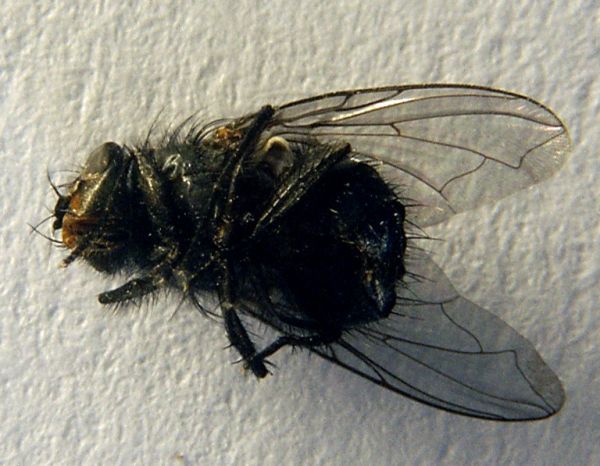Thread subject: Diptera.info :: Calliphora, but which sp?
Posted by Susan R Walter on 05-02-2006 18:52
#1
I am wondering if this is C vicina rather than C vomitoria, because of the red on the face and the small size - only 7mm.
Specimen taken 28.1.06 in a cemetery in East London now a nature reserve. Predictably, caught sunning itself on a gravestone.

Posted by Zeegers on 06-02-2006 16:52
#2
I agree, except for the 'rather'.
C. vicina is by far the most common Calliphora.
C. vomitoria is, in most cases, not common at all, actually.
Theo Zeegers
Posted by Susan R Walter on 07-02-2006 13:57
#3
Really? It is interesting then that all the general field guides feature C vomitoria, with a passing mention for C vicina. Maybe it's a childish attraction to the delightful name on publisher's part?
Posted by Zeegers on 07-02-2006 21:46
#4
Really!
I know the handbooks, that's why I draw your attention.
Maybe things were different in the time of Coyler and Hammond.
As Kahis has pointed out in another contribution, the times that a Muscid fly in house was nearly certain Musca domestica are far behind us. I think the same holds for C. vomitoria.
So, start identifying Calliphora's and let me know your experience !
Theo
Posted by Susan R Walter on 09-02-2006 14:02
#5
OK, will do. I go to the cemetery once a month, so it will be interesting to see what I come up with.
Posted by Robert Nash on 09-02-2006 16:13
#6
vicina Robineau-Desvoidy 1830
= erythrocephala Meigen 1826 (originally in Musca) =
= Calliphora turanica Rohdendorf 1926
I wonder why the appropriate Meigen name was dropped since it had priority and Robineau-Desvoidy didn't have a great reputation. I'll try and chase this one though it probably relates to confused dating of much of Meigen's work. The name vomitoria is sometimes wrongly applied to vicina in forensic literature where accuracy is of great importance (I imagine the two flies have different biology). There are two other British Isles species uralensis (Scotland and Ireland) and loewi (Scotland). Despite van Emden's 1954 (RESL Handbook) assertion that vomitoria was "very common" from the 1960's on this was certainly not so. In Ireland I finally found a few but my requests for specimens from England produced none and from generous sources too. It may well be that vicina was wrongly called vomitoria in public health literature confusing it's real status.Incidentally I have not seen Musca domestica in Ireland for ten years.
Edited by Robert Nash on 09-02-2006 16:15
Posted by Kahis on 09-02-2006 18:58
#7
According to Rognes (1991)
Musca erythrocephala Meigen 1826 is a junior primary homonym of M. erythrocephala De Geer 1776 and two other names.
Posted by gardensafarinl on 10-02-2006 15:23
#8
I followed this discussion and feel the urge to ask this. I have two flies on my site. The upper one is named Calliphora vomitaria and the lower one C. vicina, because of the red cheeks. Misguided by all books, I believed C. vomitaria to be the common one and C. vicina to be the exception. Could it be that both are C. vicina? I do not know the status of both species in Holland, but I doubt it to be very different from the situation in Britain.
Thanks for any comments.




